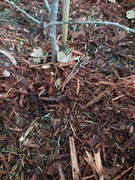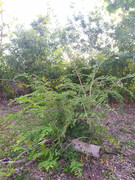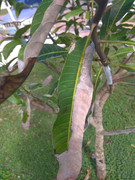Has anyone else noticed a lot of surface roots on their sugar apple/annona plants?
This week I tested my soil and it tested deficient (near void) in phosphorus so I bought some triple superphosphate to remedy the deficiency. Today I was applying it to various fruit trees and when I raked back the mulch on this small sugar apple tree that's planted on a slight mound, I noticed lots of roots were growing right up on the level where the bottom of the mulch meets the soil surface; basically up through the mulch. Here are some pictures:
The tree before raking back the mulch


The surface roots I found after raking back the mulch



The white spots near my hoe in the below picture are patches of fungi colonizing the mulch.

Curiously this was mostly happening only on the cypress mulch instead of the generic red mulch, even though cypress mulch is supposed to break down slower. Unfortunately I couldn't mix the triple superphosphate into the first few inches of soil without chopping up a lot of the surface roots so I abstained, however I did rake the mulch back over the surface roots after applying the granules and watered everything in thoroughly.
Reference picture of the leaves

It's been exactly one month since I laid this mulch down, and I've started using various fertilizers like fish emulsion. Despite the leaves being so nice and green, this tree has actually been growing very slowly and barely put out any flowers this season and hasn't set any fruit, so it was a bit cathartic to find out there was an actual deficiency behind the lack of performance.
There is also a much more established sugar apple tree planted a few feet away in a mound containing the same type of soil, and it has been displaying the same slow growth and lack of blooms/fruit set, so I also applied the triple superphosphate under its drip line.
Here's that tree last October and today after its mulch was raked back. All the defoliation in the recent picture has been there for some time prior to the very recent pruning as I've only clipped the marginal branch ends to get started on a shaping framework for the tree. You can see the wood coloration difference between the older tree branches on the lower left and a water sprout that became the dominant leader shoot.


How long does triple superphosphate usually require to take effect?




















 We can't win.
We can't win. 
 .
.






